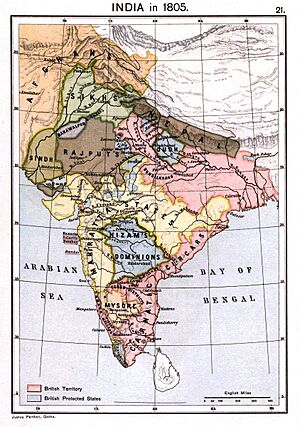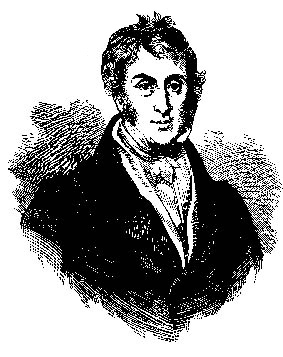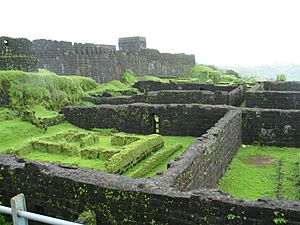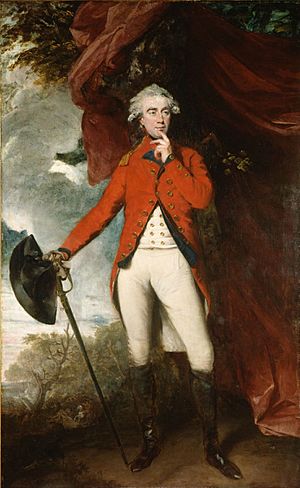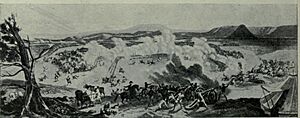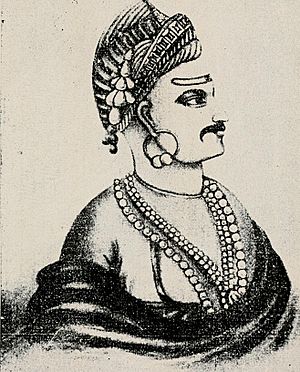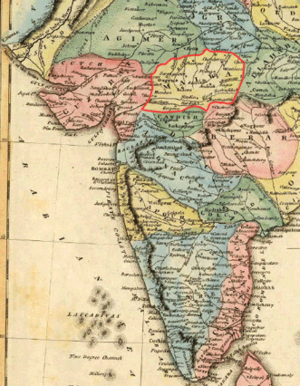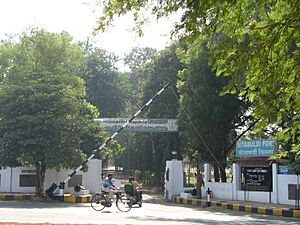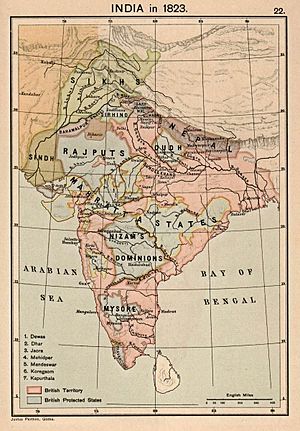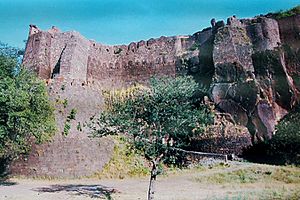Third Anglo-Maratha War facts for kids
The Third Anglo-Maratha War (1817–1819) was the last major conflict between the British East India Company and the Maratha Empire in India. This war was very important because it gave the British control over most of India. It started when British troops invaded Maratha lands. Even though the British were outnumbered, they won many battles.
The British forces were led by Governor General Hastings and General Thomas Hislop. They first went after the Pindaris, who were groups of soldiers and raiders from central India.
The Maratha leader, Peshwa Baji Rao II, along with Mudhoji II Bhonsle of Nagpur and Malharrao Holkar III of Indore, fought against the British. Another major Maratha leader, Daulatrao Shinde of Gwalior, was convinced to stay neutral. He lost control of Rajasthan because of this.
The British won quickly, which led to the end of the Maratha Empire and their independence. The Peshwa's forces fought some smaller battles to avoid being captured.
The Peshwa was eventually caught and given a small estate near Kanpur. Most of his land was taken by the British and became part of the Bombay Presidency. The Maharaja of Satara was allowed to rule his area as a princely state. However, in 1848, this land was also taken by the British. Bhonsle was defeated in the Battle of Sitabuldi, and Holkar lost at the Battle of Mahidpur. The British took over many Maratha areas, including Nagpur, Indore, Gwalior, and Jhansi. These areas became princely states that followed British rule. The British showed how good they were at fighting in India by winning quickly at Khadki, Sitabuldi, Mahidpur, and Satara.
Contents
Marathas and the British
The Maratha Empire started in 1674 with Chhatrapati Shivaji Maharaj. His capital was at Raigad. Shivaji Maharaj successfully defended his empire from the Mughal Empire. In a few decades, the Maratha Empire grew to be the most powerful in India. The Maratha government had a council of eight ministers called the Ashta Pradhan. The most important minister was the Peshwa, like a prime minister.
How British Power Grew
While the Marathas were fighting the Mughals in the early 1700s, the British had small trading posts. These were in Mumbai, Madras, and Calcutta. The British made their naval post in Mumbai stronger after seeing the Marathas defeat the Portuguese nearby in 1739.
To keep the Marathas away from Mumbai, the British sent people to make a peace agreement. They signed a treaty in 1739. This treaty allowed the British East India Company to trade freely in Maratha lands. In the south, the Nizam of Hyderabad asked the French for help against the Marathas. The Peshwa asked the British for help, but they said no. The Marathas still managed to defeat the Nizam.
Between 1750 and 1761, the British defeated the French East India Company in India. By 1793, the British were strong in Bengal (east) and Madras (south). They couldn't expand much to the west because the Marathas were powerful there. But they entered Surat on the west coast by sea.
The Maratha Empire grew and reached beyond the Indus. Two Maratha leaders, Shinde and Holkar, were in charge of the northern parts. The Peshwa was busy in the south. Shinde and Holkar did not work well together. Their actions were often based on their own interests and money needs. They upset other Hindu rulers like the Rajputs.
A big defeat for the Marathas happened in 1761 at Panipat. A combined Muslim force, led by the Afghan Ahmad Shah Abdali, defeated them. Many Maratha leaders died in that battle. However, between 1761 and 1773, the Marathas gained back their power in the north.
British and Maratha Relations
The Maratha gains in the north were lost because Holkar and Shinde had different plans. Also, there were family problems within the Peshwa's family. This led to the death of Narayanrao Peshwa in 1773. Raghunathrao was removed from being Peshwa because of these rivalries. He asked the British for help. They signed the Treaty of Surat with him in 1775. This treaty gave him military help. In return, the British got control of Salsette Island and Bassein Fort.
This treaty caused a lot of discussion among the British. They worried about fighting the strong Marathas. The treaty also started the First Anglo-Maratha War. This war ended in a tie, with neither side winning clearly. The war ended with the Treaty of Salabai in 1782. Warren Hastings helped the British succeed by breaking up the anti-British group.
The Marathas were still very strong when the new British Governor General, Cornwallis, arrived in 1786. After the Treaty of Salabai, the British tried to live peacefully with the Marathas. They had over 20 years of peace. This was thanks to Nana Phadnavis, a minister for the young Peshwa.
Things changed after Nana died in 1800. Holkar and Shinde fought for power. Holkar attacked the Peshwa in Pune in 1801 because the Peshwa sided with Shinde. The Peshwa, Baji Rao II, ran away and found safety on a British warship. Baji Rao feared losing his own power. So, he signed the Treaty of Bassein in 1802. This made the Peshwa a helper of the British.
Because of this treaty, Bhonsle and Shinde attacked the British. They refused to accept that the Peshwa had given up their freedom to the British. This started the Second Anglo-Maratha War in 1803. Both Bhonsle and Shinde were defeated. All Maratha leaders lost large parts of their land to the British.
British East India Company's Strengths
The British traveled thousands of miles to reach India. They learned about Indian geography and local languages. They were also more advanced in technology, with better equipment than what was available in India. Some historians believe the British would have won anyway because of their good discipline and organization. After the First Anglo-Maratha War, Warren Hastings said in 1783 that the peace with the Marathas was very strong.
The British felt they needed a new way to stay in touch with the Peshwa's court in Pune. They sent Charles Malet to be a permanent British representative in Pune. He knew the languages and customs of the area well.
Getting Ready for War
The Maratha Empire had become weaker after the Second Anglo-Maratha War. Their armies tried to modernize, but it was not done well. Soldiers did not learn new techniques, and old methods were no longer useful. The Maratha Empire did not have a good spy system. Their diplomacy was also weaker than the British. Maratha cannons were old, and weapons were bought from other countries. Foreign officers handled these imported guns. The Marathas did not use their own men much for this. Even though their foot soldiers were praised, they were poorly led. They also relied heavily on Arab and Pindari hired soldiers. The way the empire was set up, with different leaders, caused a lack of unity needed for wars.
When the war started, the British East India Company was getting stronger. The Maratha Empire was getting weaker. The British had won the previous war, and the Marathas were at their mercy. The Peshwa of the Maratha Empire at this time was Baji Rao II. Many Maratha leaders who used to support the Peshwa were now under British control.
The British had an agreement with the Gaekwad family of Baroda. This agreement stopped the Peshwa from collecting taxes in that area. Gaekwad sent an envoy (a messenger) to the Peshwa in Pune to discuss a tax problem. This messenger, Gangadhar Shastri, was under British protection. He was killed, and the Peshwa's minister, Trimbak Dengle, was thought to be responsible.
The British used this chance to force Baji Rao into a new treaty. The Treaty of Pune was signed on June 13, 1817. The Peshwa had to admit Dengle was guilty. He also had to give up his claims on Gaekwad's land. He had to give large parts of his territory to the British. This included important forts in the Deccan, the Konkan coast, and lands north of the Narmada River and south of the Tungabhadra River. The Peshwa was also not allowed to talk to any other powers in India. The British representative, Mountstuart Elphinstone, also asked the Peshwa to send away his cavalry (horse soldiers).
Maratha Plans
The Peshwa sent his cavalry away, but secretly told them to be ready. He even paid them seven months' salary in advance. Baji Rao asked Bapu Gokhale to get ready for war. In August 1817, the Peshwa made the forts at Sinhagad, Raigad, and Purandar stronger. Gokhale secretly hired soldiers for the coming war. Many Bhils and Ramoshis were hired. They tried to unite Bhonsle, Shinde, and Holkar. They even tried to get the Pindari hired soldiers to join them.
The Peshwa found unhappy Marathas who worked for the British. He secretly hired them. One was Jaswant Rao Ghorpade. They also tried to hire Europeans, but this failed. Some people, like Balaji Pant Natu, stayed loyal to the British. Many Indian soldiers working for the British refused the Peshwa's offers. Some even told their British officers about it.
On October 19, 1817, Baji Rao II celebrated the Dassera festival in Pune. Many troops gathered there. During the celebrations, a large group of Maratha cavalry pretended to charge at the British soldiers. But they turned away at the last moment. This was meant to insult Elphinstone and scare British soldiers into joining the Peshwa. The Peshwa even planned to kill Elphinstone, even though Gokhale disagreed. Elphinstone knew about these plans because of spies like Balaji Pant Natu and Ghorpade.
The Maratha forces were estimated to have 81,000 foot soldiers, 106,000 horsemen, and 589 cannons. The Peshwa had the most horsemen, with 28,000. He also had 14,000 foot soldiers and 37 cannons. His main base was in Pune. Holkar had the second largest cavalry with 20,000, plus foot soldiers and 107 cannons. Shinde and Bhonsle had similar numbers. Holkar was in Indore, Shinde in Gwalior, and Bhonsle in Nagpur.
The Afghan leader Amir Khan had 12,000 horsemen, 10,000 foot soldiers, and 200 cannons. The Pindaris were in central India. Three Pindari leaders, Chitu, Karim Khan, and Wasil Mohammad, sided with Shinde. They led 10,000, 6,000, and 4,000 horsemen, mostly armed with spears. Other Pindari chiefs were allied with Holkar.
British Plans
The East India Company saw the killing of their messenger, Gangadhar Shastri, as a clear sign that the Peshwa wanted to fight. So, they started operations to take full control of the region. Some people thought this war was just finishing up the Second Anglo-Maratha War. But historians note that the British gathered their largest army ever in India. This shows how important it was for them to defeat the Marathas.
The army had about 120,000 men. It included the Grand Army (or Bengal Army) led by Marquess of Hastings. There was also the Army of the Deccan led by General Hislop. This huge force had many Indian and British soldiers, cavalry, and cannons. They had the newest weapons and good supply lines.
This large force quickly made Shinde agree to terms with the British. Shinde had been secretly planning with the Peshwa and Nepal to form a group against the British. In November 1817, he was forced to sign a treaty. He gave up all his armed forces and major forts. Amir Khan sent his army away. He was given control of the area of Tonk in Rajputana. He sold his guns to the British. By doing this, the British kept two major Maratha allies out of the war before it even began.
Main Events of the War
Fighting in Pune and Chasing Baji Rao II
The war started as a campaign against the Pindaris. But the first battle happened in Pune. The Peshwa, Baji Rao II, attacked the British camp on November 5, 1817. The Maratha forces had 20,000 horsemen, 8,000 foot soldiers, and 20 cannons. The British had 2,000 horsemen, 1,000 foot soldiers, and eight cannons.
This was the Battle of Khadki. The Marathas at first broke through the British lines. But the British foot soldiers quickly moved forward, firing many shots. This made the Marathas retreat in about four hours. The British won, losing 86 men. The Marathas lost 500 men.
Pune was given to the British. The Peshwa and his forces ran away, first to Purandar and then to Satara. His commander, Bapu Gokhale, organized the retreat to protect the Peshwa.
The Peshwa then fled to Koregaon. The Battle of Koregaon happened there on January 1, 1818. Captain Stauton arrived with 500 foot soldiers, two small cannons, and 200 irregular horsemen. Only 24 of the foot soldiers were European. The rest were Indian soldiers working for the British. A fierce battle lasted all day. Streets and cannons were captured and recaptured many times. The Marathas were forced to leave the village and retreated during the night. The British lost 175 men. The Marathas lost 500 to 600 men.
After the battle, British forces chased the Peshwa. He fled south towards Karnataka with the Raja of Satara. The Peshwa kept running south through January. He did not get help from the Raja of Mysore. So, the Peshwa turned back and headed towards Solapur. The chase was not very successful. Whenever the British pressed Baji Rao, Gokhale and his light troops would fire from a distance. There were some small fights, but no clear winner.
On February 7, General Smith entered Satara and captured the Maratha royal palace. He raised the British flag there. On February 19, General Smith heard the Peshwa was going to Pandharpur. General Smith's troops attacked the Peshwa at Ashti. In this battle, Gokhale died while defending the Peshwa. The Raja of Satara was captured with his brother and mother. Gokhale's death and the fight at Ashti quickly brought the war to an end. By April 10, 1818, General Smith's forces had taken the forts of Sinhagad and Purandar.
On June 3, 1818, Baji Rao surrendered to the British. He agreed to receive a large sum of money each year for his living. Baji Rao also got promises from the British to protect his family, priests, and religious places. The Peshwa was sent to Bithur near Kanpur. While his defeat made many Marathas sad, the Peshwa lived a long life there.
Fighting the Pindaris
The Pindaris were mostly horsemen armed with spears. They were known as Shindeshahi and Holkarshahi because they were supported by these Maratha leaders. The main Pindari leaders were Chitu, Karim Khan, and Wasil Mohammad. Their total strength was about 33,000.
The Pindaris often raided villages in Central India. People thought this area was becoming a desert because farmers could not grow food. In 1815, 25,000 Pindaris entered the Madras Presidency. They destroyed over 300 villages. Other Pindari raids on British land followed in 1816 and 1817. So, Francis Rawdon-Hastings wanted to get rid of the Pindaris.
The British attacked the Pindaris. Their homes were surrounded and destroyed. General Hislop attacked the Pindaris from the south. He pushed them beyond the Narmada river, where Governor-General Hastings was waiting. The British blocked the main routes from Central India. The Pindari forces were completely broken up in one campaign. They only had spears, so they could not stand against the regular British troops. Even in small groups, they could not escape the British forces around them.
The Pindari forces could not fight the British. Their chiefs soon became outlaws, hunted down. Karim and Chitu still had 23,000 soldiers between them. But this force was no match for the armies surrounding them. Wherever they went, they met British forces. They kept losing. Many ran into the jungles. Others hid in villages, but local villagers killed them without mercy. The villagers remembered the suffering the Pindaris had caused. All the leaders had surrendered by the end of February 1818. The Pindari system and power ended. They were given land to live on in Gorakhpur. Karim Khan became a farmer. Chitu was hunted until he had no followers left. He disappeared into the jungles in 1819 and was killed by a tiger.
Events in Nagpur
Mudhoji Bhonsle, also known as Appa Saheb, became powerful in Nagpur. He signed a treaty with the British in 1816. But he ignored the British request to stop talking to Baji Rao II. The British representative, Jenkins, asked Appa Saheb to send away his growing number of troops. Appa Saheb refused. He openly supported the Peshwa, who was already fighting the British.
Since a battle was clearly coming, Jenkins asked for more British troops. He already had about 1,500 men. Jenkins sent word for Colonel Adams to march to Nagpur. Like other Maratha leaders, Appa Saheb had Arabs in his army. They were known for being brave but were hard to control. They mostly had matchlocks and swords. The Marathas had about 18,000 soldiers in total.
The British Residency was near the Sitabuldi Fort in Nagpur. The British troops took the north end of the hill near the fort. The Marathas, fighting with the Arabs, made good progress at first. They charged up the hill and forced the British to retreat. British commanders arrived with more troops. The British counterattack was strong. Appa Saheb was forced to surrender.
However, 5,000 Arabs and Hindustanis stayed inside the walls of Nagpur. The British surrounded the city from December 19. British attempts to break through the walls failed. They lost over 300 men. The British agreed to pay the defenders to leave Nagpur, which they did on December 30. A treaty was signed on January 9, 1818. Appa Saheb was allowed to rule some areas, but with many limits. Most of his land, including the forts, was now controlled by the British. They built more defenses on Sitabuldi.
A few days later, Appa Saheb was arrested. He was being taken away when he escaped to Punjab. He tried to find safety with the Sikhs, but they turned him down. He was caught again by the British near Jodhpur. He stayed in Jodhpur and died there in 1849.
Events in Holkar
The Holkar court in Indore was very weak at this time. The leader was 11-year-old Malhar Rao Holkar III. His dead father's mistress, Tulsi Bai Holkar, was ruling for him. Tulsi Bai was killed by her own troops in December 1817 because she allied with the British. Soon after, the British moved into Holkar's territory. They met his army about 40 km north of Indore at the Battle of Mahidpur.
The Battle of Mahidpur between Holkar and the British was fought on December 21, 1817. It lasted from midday until 3:00 AM. Lieutenant General Thomas Hislop led the British forces. The British lost about 800 men. But Holkar's army was destroyed, with about 3,000 killed or wounded. These losses took Holkar out of the war and broke the power of the Holkar family. The Battle of Mahidpur was a big setback for the Marathas.
The rest of Holkar's army was chased by the British. They suffered more losses in small fights. Holkar was captured. His ministers asked for peace. On January 6, 1818, the Treaty of Mandeswar was signed. Holkar accepted all the British terms. The British took a lot of war treasures. Holkar became a puppet prince under British control.
Operations Against Remaining Maratha Forces
By mid-1818, all the Maratha leaders had surrendered to the British. Shinde and the Afghan Amir Khan were brought under control through talks and pressure. This led to the Treaty of Gwalior on November 5, 1817. In this treaty, Shinde gave Rajasthan to the British. He also agreed to help them fight the Pindaris. Amir Khan agreed to sell his guns to the British. He received land in Tonk in Rajputana.
Holkar was defeated on December 21, 1817. He signed the Treaty of Mandeswar on January 6, 1818. This treaty made the Holkar state a British ally. The young Malhar Rao was made the ruler. Bhonsle was defeated on November 26, 1817. He was captured but escaped and lived out his life in Jodhpur. The Peshwa surrendered on June 3, 1818. He was sent to Bithur near Kanpur under the terms of the treaty. Of the Pindari leaders, Karim Khan surrendered. Wasim Mohammad surrendered and later poisoned himself. Setu was killed by a tiger.
In the last part of the conflict, from 1818 to 1819, the British military focused on capturing Maratha forts. These forts were still holding out under their commanders. On February 27, 1818, British forces led by Sir Thomas Hislop approached Thalner Fort. They thought it was friendly. But the fort's commander, Tulsiram Mama, ordered his troops to fire on the British. Hislop was very angry and surrounded the fort. After firing many cannons at the fort walls, he personally led an attack. They captured the fort and defeated its soldiers, who were mostly Arabs. Mama was tried and executed for his actions.
Other forts in the region, like Naralla Fort and Malegaon Fort, were slowly captured by the British. At Malegaon Fort, the British faced strong resistance. They had to bring in 2,600 more soldiers, including foot soldiers and cannons. After this, an attack party captured the fort.
In early 1819, almost all the forts had been taken. The only one left was Asirgarh Fort. It was commanded by Jeswant Rao Lar. In March of that year, a huge British army surrounded Asirgarh. They captured the town next to the fort to use as a base. The 1,200 soldiers inside the fort were constantly bombed by cannons. Then the British launched an attack and captured the fort on April 9. With the capture of Asirgarh Fort, the British victory was complete. All fighting stopped.
What Happened Next
The war left the British, through the British East India Company, in control of almost all of present-day India south of the Sutlej River. This was either by direct British rule or through princely states that followed British authority. The famous Nassak Diamond was taken by the Company as part of the war spoils. The British gained large parts of land from the Maratha Empire. This effectively ended their strongest opposition.
The terms of surrender that Malcolm offered to the Peshwa were debated among the British. Some thought they were too generous. The Peshwa was offered a luxurious life near Kanpur and a large yearly payment. People compared this to Napoleon, who was kept on a small island with less money. Trimbakji Dengale was captured after the war. He was sent to a fortress where he spent the rest of his life. With all fighting over, John Malcolm played a big part in catching and calming down the remaining people who were still fighting.
The Peshwa's lands became part of the Bombay Presidency. The land taken from the Pindaris became the center of the Central Provinces in British India. The princes of Rajputana became like feudal lords who accepted the British as the main power. So, Hastings changed the map of India. This map stayed mostly the same until the time of Lord Dalhousie.
The British recognized Pratap Singh (Raja of Satara), a direct descendant of Shivaji, as the ceremonial head of the Maratha Confederacy. Raghuji Bhonsle III, who was less than ten years old, was made the ruler of Nagpur under British care. The Peshwa adopted a son, Nana Sahib. He later became one of the leaders of the Rebellion of 1857. After 1818, Mountstuart Elphinstone reorganized how taxes were collected. This reduced the importance of local leaders like the Patil, the Deshmukh, and the Deshpande.
The new government felt they needed to talk to the local Marathi-speaking people. Elphinstone started a plan to make the Marathi language standard in the Bombay Presidency after 1820.
See also


